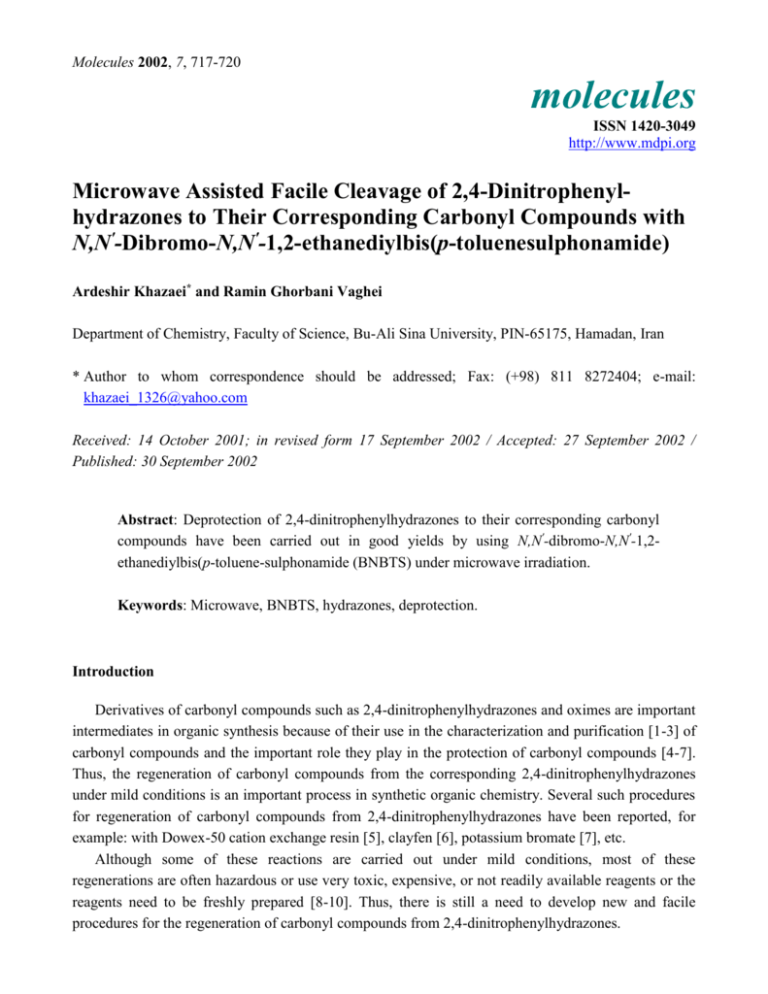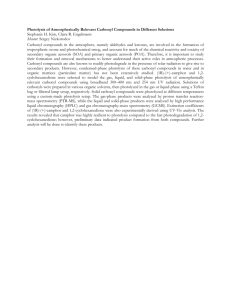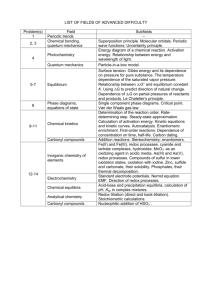Facile cleavage of 2,4-dinitrophenylhydrazones
advertisement

Molecules 2002, 7, 717-720 molecules ISSN 1420-3049 http://www.mdpi.org Microwave Assisted Facile Cleavage of 2,4-Dinitrophenylhydrazones to Their Corresponding Carbonyl Compounds with N,N′-Dibromo-N,N′-1,2-ethanediylbis(p-toluenesulphonamide) Ardeshir Khazaei* and Ramin Ghorbani Vaghei Department of Chemistry, Faculty of Science, Bu-Ali Sina University, PIN-65175, Hamadan, Iran * Author to whom correspondence should be addressed; Fax: (+98) 811 8272404; e-mail: khazaei_1326@yahoo.com Received: 14 October 2001; in revised form 17 September 2002 / Accepted: 27 September 2002 / Published: 30 September 2002 Abstract: Deprotection of 2,4-dinitrophenylhydrazones to their corresponding carbonyl compounds have been carried out in good yields by using N,N′-dibromo-N,N′-1,2ethanediylbis(p-toluene-sulphonamide (BNBTS) under microwave irradiation. Keywords: Microwave, BNBTS, hydrazones, deprotection. Introduction Derivatives of carbonyl compounds such as 2,4-dinitrophenylhydrazones and oximes are important intermediates in organic synthesis because of their use in the characterization and purification [1-3] of carbonyl compounds and the important role they play in the protection of carbonyl compounds [4-7]. Thus, the regeneration of carbonyl compounds from the corresponding 2,4-dinitrophenylhydrazones under mild conditions is an important process in synthetic organic chemistry. Several such procedures for regeneration of carbonyl compounds from 2,4-dinitrophenylhydrazones have been reported, for example: with Dowex-50 cation exchange resin [5], clayfen [6], potassium bromate [7], etc. Although some of these reactions are carried out under mild conditions, most of these regenerations are often hazardous or use very toxic, expensive, or not readily available reagents or the reagents need to be freshly prepared [8-10]. Thus, there is still a need to develop new and facile procedures for the regeneration of carbonyl compounds from 2,4-dinitrophenylhydrazones. Molecules 2001, 6 718 Result and Discussion We have previously reported a convenient method for the deoximation of ketone and aldehyde oximes to their corresponding carbonyl compounds [11] using the new reagent N,N′-dibromo-N,N′-1,2ethanediylbis(p-toluenesulphonamide) (BNBTS, 2) that was prepared from N,N′-1,2-ethanediylbis(p-toluenesulphonamide) (1, Figure 1) [12]. Herein, we wish to report a mild, clean, fast, economical and convenient method for the oxidative deprotection of 2,4-dinitrophenylhydrazones with this reagent under microwave irradiation. Figure 1. CH3 SO2 CH3 N CH2 )2 SO2 H N CH2 )2 Br 1 BNBTS (2) 2,4-Dinitrophenylhydrazones 3 reacted with BNBTS (2) in CH2Cl2 under microwave irradiation to afford the corresponding carbonyl compounds 4 without any detectable byproducts (Scheme 1). The reaction products were isolated simply by filtering off compound 1 and evaporating the solvent from the filtrate. The results of the conversion of various 2,4-dinitrophenylhydrazones to their ketones and aldehydes are presented in Table 1. Scheme 1. 1 R 1 R BNBTS C= N R NH NO2 2 , CH2C l2 MW C= O + 1 R2 NO2 3 4 Conclusions From the obtained results, we find that the described procedure is simple and the reaction conditions are simple. The reagent (BNBTS) is stable and the recovered reagent can be reused. Molecules 2001, 6 719 Table 1. Cleavage of 2,4-dinitrophenylhydrazones with BNBTS under microwave irradiation a Entry R1 R2 Producta Reaction Times (min) Yield(%) 1 2 3 4 5 6 7 8 9 10 11 CH3 CH3 CH3 CH3 C6H5 C6H5 H H H H C6H5 C6H5 p-ClC6H5 p-MeOC6H5 p-BrC6H5 C6H5 p-ClC6H5 C6H5 p-ClC6H5 p-MeC6H5 o-MeOC6H5 C6H5CH(OH) Acetophenone p-Chloroacetophenone p-Methoxyacetophenone p-Bromoacetophenone Benzophenone p-Chlorobenzophenone Benzaldehyde p-Chlorobenzaldehyde p-Tolualdehyde o-Methoxybenzaldehyde Benzoin 50 60 50 50 60 30 50 40 50 40 50 91 92 94 93 90 92 89 95 92 92 91 Products were characterized by their physical constants, comparison with authentic samples and IR spectra. Acknowledgements The authors are grateful to Bu-Ali Sina University Research Council for partial financial support of this work. Experimental General IR spectra (KBr pellets) were recorded using a Shimadzu 435-U-04 spectrophotometer. The 2,4dinitrophenylhydrazones were prepared by a standard procedure [13]. The purity of all compounds was checked by TLC (Silica gel 60 F254/CHCl3 and CCl4/UV). The microwave used (input 220V, 50Hz, RF output 2450 MHz 700 W) was manufactured by Shivaki Co., Japan. General procedure for facile cleavage of 2,4-dinitrophenylhydrazones with BNBTS under microwave irradiation. A mixture of 2,4-dinitrophenylhydrazone (5 mmol), dichloromethane (15 mL) and BNBTS (5 mmol) was introduced in a flask and was refluxed under irradiated in a microwave oven at a power output of 700 W for the appropriate time indicated in Table 1. After irradiation, cold water was added to hydrolyze the intermediate, and the insoluble sulfonamide 1 was removed by filtration and washed with cold dichloromethane (10 mL). The organic layer was separated from aqueous layer and dried with MgSO4. Dichloromethane was removed under reduced pressure gave the crude product. Solid products were recrystallized from diethyl ether, oily products were dissolved in ether and the ether solution washed, dried and concentrated. Molecules 2001, 6 720 References 1. 2. 3. 4. 5. 6. 7. 8. Zhang, G.S.; Gong, H.; Yang, D. H.; Chen, M. F. Synth. Commun. 1999, 29, 1165. Gillam, A.E.; West, T. F. J. Chem. Soc. 1945, 95. Hershberg, E. B. J. Org. Chem. 1948, 13, 542. Kirk, D. N.; Slade, C. J. Tetrahedron Lett. 1980, 21, 651. Ranu, B. C.; Sarkar, D. C. J. Org. Chem. 1988, 53, 878. Laszlo, P.; Polla, E. Synthesis, 1985, 439. Narayanan, S. Srinivasan, V. S. J. Chem. Soc. Perkin Trans. 2, 1986, 1557. Greene, T.W.; Wuts, P.G.M. Protective Groups in Organic Synthesis; John Wiley and Sons: New York, 1991. 9. Kabalka, G. W.; Pace, R. D.; Wadgaonkaf, P. P. Synth. Commun. 1990, 20, 2453. 10. Bandgar, B. P.; Shaikh, S. I.; Iyyer, S. Synth. Commun. 1996, 26, 1163. 11. Khazaei, A.; Vaghei, R. G.; Tajbakhsh, M. Tetrahedron Lett. 2001, 42, 5099. 12. Khazaei, A.; Shirdarreh, A. Synth. Commun. 1999, 29, 4079. 13. Shriner, R. L.; Fuson, R. C.; Curtin, D. Y.; Morrill, T. C. The Systematic Identification of Organic Compounds; 6 th. Ed, John Wiley and Sons: New York, 1980. Sample Availability: Samples of compounds 1 and 2, entries 1, 5, 7 and 11 in Table 1 and the oximes of acetophenone, benzophenone, benzoin and cinnamaldehyde are available from MDPI. © 2001 by MDPI (http://www.mdpi.org). Reproduction is permitted for noncommercial purposes.





